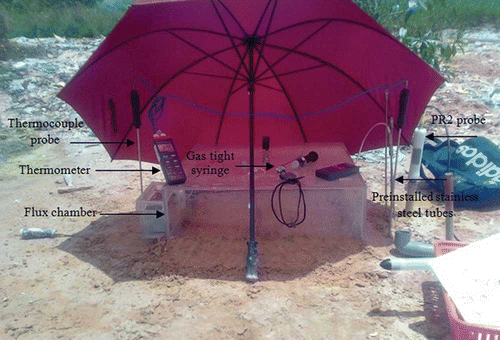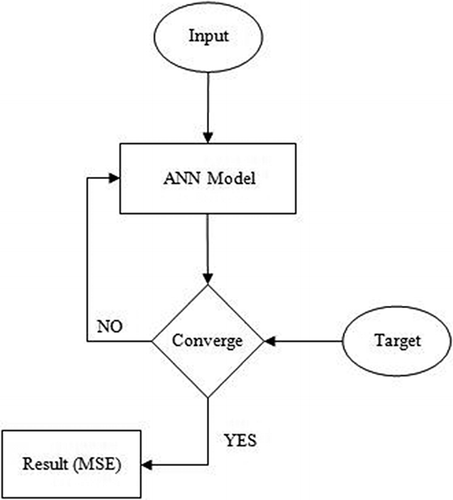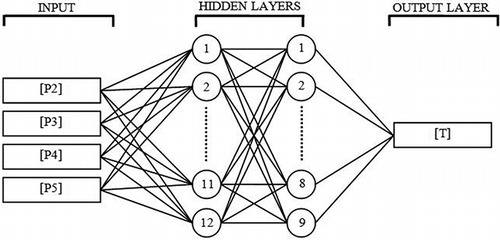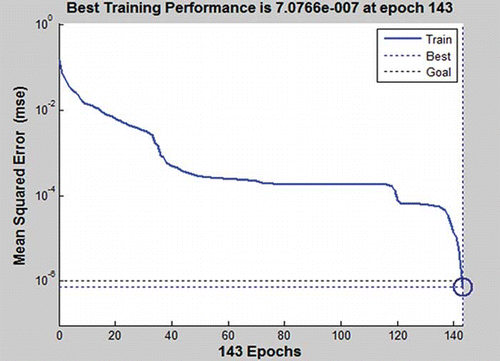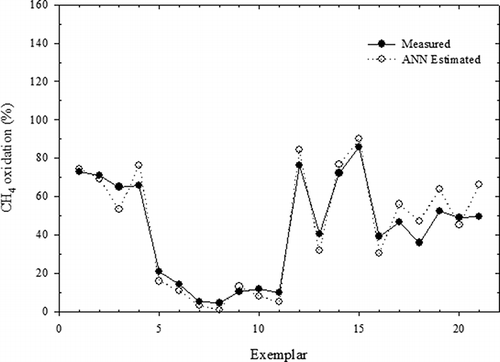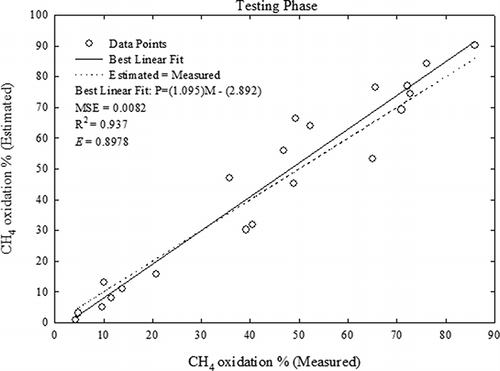Abstract
Knowing the fraction of methane (CH4) oxidized in landfill cover soils is an important step in estimating the total CH4 emissions from any landfill. Predicting CH4 oxidation in landfill cover soils is a difficult task because it is controlled by a number of biological and environmental factors. This study proposes an artificial neural network (ANN) approach using feedforward backpropagation to predict CH4 oxidation in landfill cover soil in relation to air temperature, soil moisture content, oxygen (O2) concentration at a depth of 10 cm in cover soil, and CH4 concentration at the bottom of cover soil. The optimum ANN model giving the lowest mean square error (MSE) was configured from three layers, with 12 and 9 neurons at the first and the second hidden layers, respectively, log-sigmoid (logsig) transfer function at the hidden and output layers, and the Levenberg-Marquardt training algorithm. This study revealed that the ANN oxidation model can predict CH4 oxidation with a MSE of 0.0082, a coefficient of determination (R 2) between the measured and predicted outputs of up to 0.937, and a model efficiency (E) of 0.8978. To conclude, further developments of the proposed ANN model are required to generalize and apply the model to other landfills with different cover soil properties.
Implications:
To date, no attempts have been made to predict the percent of CH4 oxidation within landfill cover soils using an ANN. This paper presents modeling of CH4 oxidation in landfill cover soil using ANN based on field measurements data under tropical climate conditions in Malaysia. The proposed ANN oxidation model can be used to predict the percentage of CH4 oxidation from other landfills with similar climate conditions, cover soil texture, and other properties. The predicted value of CH4 oxidation can be used in conjunction with the Intergovernmental Panel on Climate Change (IPCC) First Order Decay (FOD) model by landfill operators to accurately estimate total CH4 emission and how much it contributes to global warming.
Introduction
Microbial methane (CH4) oxidation in landfill cover soils provides a mean of controlling CH4 emissions (CitationHuber-Humer, 2004; CitationHuber-Humer et al., 2008; CitationStern et al., 2007). It is facilitated by a group of methanotrophic bacteria that live in landfill cover soil and have the ability to oxidize CH4 using migrated atmospheric oxygen (O2) under natural conditions to produce carbon dioxide (CO2), water (H2O), and microbial biomass, as shown in Equationeq 1.
CH4 oxidation values differ in landfill cover soils due to several factors that affect the oxidation process. A value of 0–10% oxidation is recommended by the Intergovernmental Panel on Climate Change (IPCC) guidelines for national greenhouse gas (GHG) inventories. However, laboratory and field studies indicate that CH4 oxidation capacity lies between 0% and 100% (CitationJugnia et al., 2008). Therefore, it is important to understand the factors that control CH4 oxidation in landfill cover soils to model CH4 oxidation and subsequently achieve reductions in GHG emissions.
Several factors affect CH4 oxidation in landfill cover soils. The most important factors reported in the literature were soil texture, organic matter, moisture content, temperature, pH, nutrients, O2 concentration, and CH4 concentration (CitationBoeckx et al., 1996; CitationBorjesson et al., 2001; CitationSpokas and Bogner, 2011; CitationWilshusen et al., 2004). However, climate and season also have an impact on oxidation capacity. CH4 oxidation is expected to be less in subarctic or highland regions due to colder temperatures, in subtropical regions due to the relatively dry conditions of cover soils, and in humid continental regions as a result of longer, colder winters, and more dry summers (CitationOonk, 2010). Several attempts to model CH4 oxidation in landfill cover soils have previously been made. Most of the current models are analytical models based on fundamental scientific laws governing oxidation processes (CitationDe Visscher and Cleemput, 2003; CitationPerera et al., 2002; CitationStein et al., 2001), whereas few models are based on an empirical statistical modeling approach (CitationAlbanna et al., 2007).
The artificial neural network (ANN) is an empirical modeling approach that can determine relationships between different sets of data and is capable of solving problems where statistical models are insufficient (CitationZhou, 2003). ANN is defined by CitationAbrahart (2004) as “structures which forecast and predict through pattern matching and comparison.” The ANN has been used in many fields to perform complex functions, such as pattern recognition, classification, vision, control systems, and prediction (CitationZilouchian, 2001). In prediction modeling, the ANN takes a set of inputs and produces one or more outputs. This task is accomplished by teaching the ANN, based on a set of input/output data that assists the ANN in obtaining knowledge on system dynamics and uses this knowledge to predict a system output for any given input (CitationZhou, 2003; CitationZilouchian, 2001). The ANN modeling technique is not comprehensive, as it cannot simulate processes outside the input variables domain. Therefore, a large number of experimental data are required, which may be site or case specific, for providing a viable predicting tool.
To date, no attempts have been made to predict the percent of CH4 oxidation within landfill cover soils using an ANN, but many applications of ANN modeling in the field of environmental engineering exist. In the field of wastewater treatment, CitationHamed et al. (2004) developed an ANN model to predict wastewater performance in a treatment plant, whereas CitationElmolla et al. (2010) used a three-layer ANN to model chemical oxygen demand (COD) removal from wastewater. However, CitationTashaouie et al. (2012) developed an ANN model for predicting filter efficiency in the removal of turbidity from a municipal water treatment plant. CitationOnkal-Engin et al. (2005) determined the relationship between sewage odor and biological oxygen demand (BOD) using an ANN, and CitationKardam et al. (2010) developed a two-layer ANN model to predict the removal efficiency of cadmium(II) ions from an aqueous solution using shelled Moringa oleifera seed powder. In the field of landfill gas (LFG) concentration and emission, CitationOzkaya et al. (2007) developed an ANN model to predict the CH4 fraction in LFG using conventional leachate parameters such as pH, alkalinity, COD, sulfate, conductivity, chloride concentration, and waste temperature, whereas CitationLi et al. (2011) developed an ANN model for predicting temperature, and CH4, CO2, and O2 concentrations at several gas collection wells at a large landfill in southern California, USA. CitationKaracan (2008) developed an ANN-based methodology to predict the ventilation of CH4 emissions from longwall mines and CitationAl-Quraishi and Shokir (2011) provided two models for predicting natural gas viscosity and density using independent input variables of gas pressure and temperature. In the geotechnical field, CitationZhao et al. (2009) used an ANN model to predict soil texture (sand, clay, and silt) based on soil attribute parameters.
The present study developed an ANN model to estimate the percentage of CH4 oxidized in landfill cover soil, to enhance the determination of total CH4 emissions from a landfill using IPCC First Order Decay (FOD) model. Several variables, such as average air temperature (°C), average soil temperature (°C) at a 10-cm depth of cover soil, average volumetric soil moisture content over soil depths (% v/v), CH4 concentration (% v/v) underlying the bottom of soil cover, and O2 concentration (% v/v) at a 10-cm depth of cover soil, were tested to select the main variables. The ANN modeling outputs were compared with the measured data.
Materials and Methods
Site description
The Sungai Sedu open dump landfill was used to gather the data required to model CH4 oxidation. The Sungai Sedu open dump landfill is located in Kuala Langat, Selangor, Malaysia (2°50′39″N and 101°31′01″E) and is adjacent to the Sungai Sedu River (). The landfill has a total area of 5.5 ha and receives approximately 340 tons per day of domestic and nonhazardous industrial waste. The total amount of waste disposed of in the landfill was estimated to be 1,613,300 tons. The landfill was operated and managed by Alam Flora Sdn. Bhd, and since 2010, the landfill has been full and not in use.
Figure 1. Aerial view of the Sungai Sedu landfill indicating the location of the study area and monitoring stations.
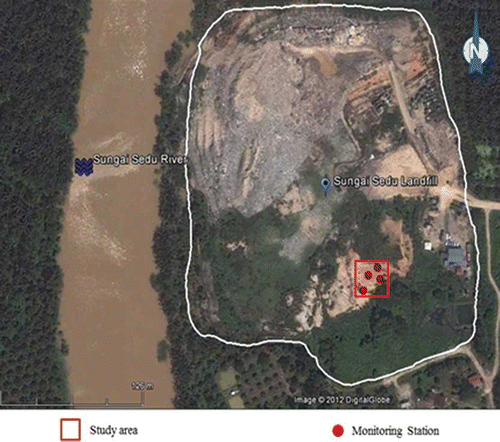
In the present study, measurements were gathered at the inactive part of the landfill, from cell number 5 (). Cell number 5 consists of waste between 2 and 12 years old; the cell started receiving waste in 1998 and closed in 2008. The waste depth of the cell is approximately 34 m. The cell is covered by approximately 10 to 30 cm of poorly graded sand, which functions as an interim soil layer. The vegetation was not well established at some parts of the cell at the time of the study, whereas other parts were covered with grasses and herbs. The cell was not lined and at the time of the study, there was no gas collection system, and thus the waste gases directly escaped through the cover soil and were released into the atmosphere.
Experimental procedure
To provide data for modeling CH4 oxidation from the Sungai Sedu landfill, four monitoring locations in a square portion with an area of approximately 1000 m2 were chosen randomly, as shown in . CH4 and CO2 emissions on the surface and soil gas concentration profiles at those locations were measured between 9:00 and 11:00 a.m. twice per month from September 2010 to June 2011. Furthermore, two of the four monitoring stations were selected randomly for temporal sampling once per month in the morning (8:00–10:00 a.m.), at noon (12:00–2:00 p.m.), and during the afternoon (3:00–5:00 p.m.) over the monitoring period.
A square static flux chamber was constructed and used to measure the CH4 and CO2 emissions followed CitationAbushammala et al. (2012) (). Soil gas at each monitoring station was trapped by preinstalled stainless steel tubes, in accordance with the method by CitationKiese and Butterbach-Bahl (2002), and collected using 10-mL gas-tight syringes for direct analysis. The concentrations of three main soil gases were measured: CH4, CO2, and O2. The combination of surface CH4 and CO2 emissions and soil gas concentration profiles was used to estimate the percentage of CH4 oxidized in the soil cover, in accordance with the method by Christophersen et al. (2001). The gas analyses were performed on a Varian Micro-GC (CP-4900; Varian, Inc., Australia) gas chromatograph (CitationAbushammala et al., 2012). Helium gas (99.999%) was used as the carrier gas for the thermal conductivity detector (TCD) at a pressure of 80 psi. Further details of the Micro-GC are shown in . Each gas sample was analyzed at least twice, and the average was determined. The gas components from each sample were detected in a typical 1.5 min and automatically integrated using the Galaxie software.
Table 1. Micro-GC parameters for gas determination
For modeling of CH4 oxidation using ANN, the following parameters were measured simultaneously with CH4 and CO2 emissions and soil gas profiles at each monitoring station: soil temperature at a 10-cm depth, air temperature, and volumetric soil water content. Each parameter was measured at least twice and the average was determined.
Analytical methods
Air temperature was measured using Skymaster (Great Falls, Virginia, USA) SM-28 and Speedtech instruments. The soil temperature at a depth of 10 cm was measured using a thermometer dual channel, type K, Monarch 306, connected with two K wire thermocouple probes (Monarch Instrument, Amherst, New Hampshire, USA) (). An integrated profile probe (PR2) connected to a moisture meter (HH2) was used to measure the soil volumetric moisture content profile. The PR2 probe was inserted into preinstalled access tubes, and measurements were taken at different depths (). A soil sieve analysis of particle density, moisture content, bulk density, pH, and organic matter was conducted following the method by CitationHead (1992) and was previously presented (CitationAbushammala et al., 2013).
ANN modeling
Data sets (121 experimental sets) obtained from our previous study of field investigations of the Sungai Sedu landfill (CitationAbushammala et al., 2013) were used to develop the ANN oxidation model. As an initial step, the data sets were normalized and then divided into an input matrix and target matrix. CH4 oxidation (%) was used as a target. To find the appropriate input parameters for developing the ANN oxidation model, an initial ANN structure with two hidden layers comprising 15 and 10 neurons for the first and the second layers, respectively, was used to evaluate the performance of combinations of measured variables (CitationKaracan, 2008). The measured variables were p 1 (soil temperature), p 2 (air temperature), p 3 (soil moisture content), p 4 (CH4 concentration at the bottom of the cover soil), and p 5 (O2 concentration at a 10-cm depth of cover soil). The entire data set was first randomized to prevent bias and to construct representative sections of the data set for the training and testing phases. Subsequently, the whole data set was divided into 100 exemplars (83%) for training data and 21 exemplars (17%) for the testing phase.
The initial ANN type was feedforward. The supervised backpropagation is the most popular training method (CitationAbrahart, 2004; CitationRene and Saidutta, 2008) and, therefore, was used for training the initial ANN using the Levenberg-Marquardt training algorithm (trainlm). The training process between both input and expected output was repeated until the performance error decreased to an acceptable level and the internal connection weights were modified in response to the computed error. For a single iteration, the error is calculated and the summed errors from overall neurons are divided by the size of data used in the training process to estimate average MSE (). The log-sigmoid transfer function (logsig) was selected at the hidden and output layers, as it is the most common type of the transfer function used to construct neural networks (CitationMjalli et al., 2007) and is commonly used in backpropagation networks (CitationBishop, 1995). The momentum factor of 0.92 was constant.
To evaluate the performance of the initial models, the mean square errors (MSE), coefficient of determination (R 2), and model efficiency (E) were noted during the testing phase. The model efficiency was estimated using Equationeq 2 (CitationSingh and Panda, 2011):
Results and Discussion
Selection of effective input variables
This section presents the results of initial modeling to find the effective input variables for the final ANN oxidation model. The combination between variables was subsequently changed to determine which input variables produced the smallest MSE and highest R 2 and E values in the testing phase. summarizes the performance of the combination of variables used in the initial models in the testing phase.
Table 2. Evaluation of variable efficiency in estimating CH4 oxidation
The initial modeling indicated that “model 8” was the best model, as it produced the smallest MSE (0.0252) and the greatest R 2 (0.785) and E (0.6858) compared with other models in the group of two variables. In the group of three variables, “model 19” achieved the smallest MSE compared with other models in the same group and “model 8,” with an MSE of 0.0189, an R 2 of 0.821 and an E of 0.7643. In the group of four variables, “model 24” was the best model, producing the lowest MSE and highest R 2 compared with other models in the same group as well as with the other group models, including the group of five variables. In a test of “model 24,” an MSE of 0.0146, R 2 of 0.828, and E of 0.8177 were achieved. “Model 24” had the lowest MSE in the testing phase of the groups of two, three, and five variables up to 42%, 22.8%, and 45.3%, respectively. Similarly, R 2 and E values improved from 0.785 to 0.828 and from 0.6858 to 0.8177, respectively. Thus, the “model 24” variables were the most effective inputs among other variables in the other groups. Subsequently, the air temperature (°C), average volumetric soil moisture content over soil depths (% v/v), CH4 concentration (% v/v) underlying bottom of soil cover, and O2 concentration (% v/v) at a 10-cm depth of cover soil were selected as the input variables for the CH4 oxidation ANN model. shows the descriptive statistics of the experimental data of these input variables as well as the CH4 oxidation values.
Table 3. Summary of descriptive statistics of the experimental data
Selection of backpropagation training algorithm
After selecting the “model 24” input parameters, 10 backpropagation training algorithms were used to determine the best training algorithm for the gathered data. For all algorithms, a three-layered approach with a log-sigmoid transfer function (logsig) at hidden layers and an output layer was used. In addition, 15 and 10 neurons were used in the first and the second hidden layers, respectively, as initial values for all backpropagation algorithms. The momentum was a constant 0.92 for all the algorithms used. The testing phase results with different backpropagation training algorithms are provided in . Compared with other backpropagation algorithms, Levenberg-Marquardt (trainlm) was the best algorithm, producing the lowest MSE, and was associated with the highest R 2 and E values in the testing phase. Using the Levenberg-Marquardt algorithm resulted in a decrease of up to 27.3% of the MSE produced compared with using the Powell-Beale conjugate gradient algorithm, which was the algorithm that produced the second lowest MSE (). Subsequently, the Levenberg-Marquardt algorithm was considered for training the final ANN oxidation model.
Table 4. Comparison of backpropagation algorithms
Optimization of neuron numbers
Optimization of neural network neuron numbers is an important task in developing the best ANN model. Therefore, the optimum network neuron numbers were investigated in the current study to improve the estimation performance of the ANN oxidation model. The number of hidden layers chosen was two, as it was during the initial ANN structure. The Levenberg-Marquardt backpropagation training algorithm was used for training different ANN models with different neuron numbers at the first and second hidden layers. The log-sigmoid transfer function was used at the hidden layers and the output layer during the training phase, whereas the value of momentum was a constant of 0.92.
In the first stage, neuron numbers in the first hidden layer varied from 10 to 20, whereas neuron numbers in the second hidden layer were kept constant at 10. The optimal number of neurons in the first hidden layer was chosen based on the smallest MSE and highest R 2 and E values in the testing phase. In the second stage, the optimum number of neurons in the first hidden layer, selected during the first stage, was kept constant, whereas the number of neurons in the second hidden layer varied and ranged from 2 to 12. Thus, the optimum number of neurons in the second hidden layer that were associated with the smallest MSE and highest R 2 and E values in the testing phase were selected. and show the performance of different models with varying neuron numbers between the two hidden layers. The best model performance, according to minimum MSE and greatest R 2 and E values in the testing phase, are highlighted in and .
Table 5. Performance of different models tested in ANN with a varying number of neurons in the first hidden layer and a constant number of neurons in the second hidden layer
Table 6. Performance of different models tested in ANN with a constant number of neurons in the first hidden layer and a varying number of neurons in the second hidden layer
The results in show that the 12 neurons in the first hidden layer produced smaller MSE and higher R 2 and E values compared with other models. However, the results in show that the 9 neurons in the second hidden layer produced smaller MSE and higher R 2 and E values in contrast to other models. Therefore, 12 and 9 neurons were selected as the best number of neurons in the first and second hidden layers, respectively. shows the optimized ANN structure for estimating CH4 oxidation, whereas shows the linear regression between the measured CH4 oxidation and the ANN model outputs in the training phase. The optimum ANN training process took 143 epochs () to reach the error goal (10−6). The MSE in the training phase was 7.0766 × 10−7, and the R 2 and E values were 1 (). shows the training MSE with respect to epochs of the selected model.
The targets of oxidation in the test data set were compared and plotted with the estimated values using the ANN model in . The comparison between the target data and the estimated values in the testing phase is shown in . Although the target data exhibited large variations, it was obvious that the ANN model outputs were reasonable and mimicked the target data. shows the linear regression between the ANN model outputs and the corresponding targets in the testing phase, and the outputs appear to track the targets reasonably well. The figure contains the best linear equation y = 1.095x − 2.892, with an R 2 of 0.937. The R 2 value found in this study was relatively higher than those reported in the literature; a coefficient of determination of 0.92 for prediction of CH4 emission ventilation from longwall mines (CitationKaracan, 2008), 0.90 for prediction of the CH4 fraction of LFG (CitationOzkaya et al., 2007), 0.90 for prediction of the quantitative characteristics of water bodies (CitationPalani et al., 2008), and 0.90 for prediction of performance of a wastewater treatment plant (CitationNasr et al., 2012). However, some previous studies achieved R 2 values up to 0.99 (CitationElmolla et al., 2010; CitationOguz et al., 2008; CitationSalari et al., 2005). The relatively low values of R 2 and E of the ANN oxidation model obtained by this study might be attributed to data noise, due to the small sample size of the data set.
The proposed ANN oxidation model can be used to estimate the percentage of CH4 oxidation from other landfills with similar climate conditions, and cover soil texture and other properties in which the data were collected. Therefore, further field investigations and data collection of CH4 oxidation and the inputs from different cover soil properties are required for developments and enhancements of the proposed ANN oxidation model to apply the model to other landfills. Furthermore, the ANN oxidation model can be incorporated with the IPCC 2006 First Order Decay (FOD) model to accurately estimate total CH4 emissions from landfill surfaces.
Conclusions
This study presents estimation of CH4 oxidation (%) in landfill cover soil by considering environmental factors, such as air temperature, soil moisture content, and O2 and CH4concentrations at the top and bottom of cover soil, respectively. These selected environmental factors were the result of initial modeling and were determined to be the most effective parameters producing the smallest MSE and highest coefficient of determination in estimating CH4 oxidation. The optimum ANN configuration giving the smallest MSE was a three-layer backpropagation, with 12 and 9 neurons at the first and the second hidden layers, respectively. The Levenberg-Marquardt backpropagation training algorithm was the best algorithm, producing the smallest MSE compared with other training algorithms. The results of this study indicated a small MSE (0.0082), a relatively high coefficient of determination (R 2) between the measured and estimated values, reaching up to 0.937, and a relatively high model efficiency (E) of 0.8978.
In conclusion, the ANN oxidation model provides an effective tool for estimating percent of CH4 oxidation in landfill cover soil with similar properties of that where the data had been collected and with the same range of experimental data that were used to train the model. However, the model cannot be used with different cover soil properties or input values outside the range of the trained data.
Acknowledgment
The authors gratefully acknowledge the Alam Flora Company staff for their assistance with this research and Tuwati B. Tuwati for his assistance with field sampling.
Funding
This work was financed by Universiti Kebangsaan Malaysia (UKM) under research grant UKM-GUP-ASPL-08-06-208.
References
- Abushammala , M.F.M. , Basri , N.E.A. , Basri , H. , Kadhum , A.A.H. and El-Shafie , A.H. 2012 . Methane and carbon dioxide emissions from Sungai Sedu open dumping during wet season in Malaysia . Ecol. Eng , 49 : 254 – 263 . doi: 10.1016/j.ecoleng.2012.08.013
- Abushammala , M.F.M. , Basri , N.E.A. , Basri , H. , Kadhum , A.A.H. and El-Shafie , A.H. 2013 . Empirical gas emission and oxidation measurement at cover soil of dumping site: Example from Malaysia . Environ. Monit. Assess , 185 : 4919 – 4932 . doi: 10.1007/s10661-012-2913-5
- Abrahart , R.J. 2004 . “ Neural networks for hydrological modeling ” . In Neural Network Modelling , Edited by: Abrahart , R.J. , Kneale , P.E. and See , L.M. 15 – 37 . London : Taylor & Francis .
- Albanna , M. , Fernandes , L. and Warith , M. 2007 . Methane oxidation in landfill cover soil; the combined effects of moisture content, nutrient addition, and cover thickness . J. Environ. Eng. Sci , 6 : 191 – 200 . doi: 10.1139/s06-047
- Al-Quraishi , A.A. and Shokir , E.M. 2011 . Artificial neural networks modeling for hydrocarbon gas viscosity and density estimation . J. King Saud Univ. Eng. Sci , 23 : 123 – 129 . doi: 10.1016/j.jksues.2011.03.004
- Bishop , C. 1995 . Neural Networks for Pattern Recognition , New York : Oxford University Press .
- Boeckx , P. , Cleemput , O.V. and Villaralvo , I. 1996 . Methane emission from a landfill and the methane oxidizing capacity of its covering soil . Soil Biol. Biochem , 28 : 1397 – 1405 . doi: 10.1016/S0038-0717(96)00147-2
- Borjesson , G. , Chanton , J. and Svensson , B.H. 2001 . Methane oxidation in two Swedish landfill covers measured with carbon-13 to carbon-12 isotope ratios . J. Environ. Qual , 30 : 369 – 376 . doi: 10.2134/jeq2001.302369x
- De Visscher , A. and Cleemput , O.V. 2003 . Simulation model for gas diffusion and methane oxidation in landfill cover soils . Waste Manage , 23 : 581 – 591 . doi: 10.1016/S0956-053X(03)00096-5
- Elmolla , E.S. , Chaudhuri , M. and Eltoukhy , M.M. 2010 . The use of artificial neural network (ANN) for modeling of COD removal from antibiotic aqueous solution by the Fenton process . J. Hazard. Mater , 179 : 127 – 134 . doi: 10.1016/j.jhazmat.2010.02.068
- Hamed , M.M. , Khalafallah , M.G. and Hassanien , E.A. 2004 . Prediction of wastewater treatment plant performance using artificial neural networks . Environ. Modell. Softw , 19 : 919 – 928 . doi: 10.1016/j.envsoft.2003.10.005
- Head , K.H. 1992 . Manual of Soil Laboratory Testing , London : Pentech Press .
- Huber-Humer , M. 2004 . International research into landfill gas emissions and mitigation strategies-IWWG working group “CLEAR” . Waste Manage , 24 : 425 – 427 . doi: 10.1016/j.wasman.2004.02.005
- Huber-Humer , M. , Gebert , J. and Hilger , H. 2008 . Biotic systems to mitigate landfill methane emissions . Waste Manage. Res , 26 : 33 – 46 . doi: 10.1177/0734242X07087977
- Jugnia , L.-B. , Cabral , A.R. and Greer , C.W. 2008 . Biotic methane oxidation within an instrumented experimental landfill cover . Ecol. Eng , 33 : 102 – 109 . doi: 10.1016/j.ecoleng.2008.02.003
- Karacan , C.O. 2008 . Modeling and prediction of ventilation methane emissions of U.S. longwall mines using supervised artificial neural networks . Int. J. Coal Geol , 73 : 371 – 387 . doi: 10.1016/j.coal.2007.09.003
- Kardam , A. , Raj , K.R. , Arora , J.K. , Srivastava , M.M. and Srivastava , S. 2010 . Artificial neural network modeling for sorption of cadmium from aqueous system by shelled Moringa oleifera seed powder as an agricultural waste . J. Water Res. Protect , 2 : 339 – 344 . doi: 10.4236/jwarp.2010.24039
- Kiese , R. and Butterbach-Bahl , K. 2002 . N2O and CO2 emissions from three different tropic forest sites in the wet tropics of Queensland, Australia . Soil Biol. Biochem , 34 : 975 – 987 . doi: 10.1016/S0038-0717(02)00031-7
- Li , H. , Sanchez , R. , Joe Qin , S. , Kavak , H.I. , Webster , I.A. , Tsotsis , T.T. and Sahimi , M. 2011 . Computer simulation of gas generation and transport in landfills. V: Use of artificial neural network and the genetic algorithm for short- and long-term forecasting and planning . Chem. Eng. Sci , 66 : 2646 – 2659 . doi: 10.1016/j.ces.2011.03.013
- Mjalli , F.S. , Al-Asheh , S. and Alfadala , H.E. 2007 . Use of artificial neural network black-box modeling for the prediction of wastewater treatment plants performance . J. Environ. Manage , 83 : 329 – 338 . doi: 10.1016/j.jenvman.2006.03.004
- Nasr , M.S. , Moustafa , M.A.E. , Seif , H.A.E. and El Kobrosy , G. 2012 . Application of Artificial Neural Network (ANN) for the prediction of EL-AGAMY wastewater treatment plant performance-EGYPT . Alexandria Eng. J , 51 : 37 – 43 . doi: 10.1016/j.aej.2012.07.005
- Oguz , E. , Tortum , A. and Keskinler , B. 2008 . Determination of the apparent rate constants of the degradation of humic substances by ozonation and modeling of the removal of humic substances from the aqueous solutions with neural network . J. Hazard. Mater , 157 : 455 – 463 . doi: 10.1016/j.jhazmat.2008.01.018
- Onkal-Engin , G. , Demir , I. and Engin , S.N. 2005 . Determination of the relationship between sewage odour and BOD by neural networks . Environ. Modell. Softw , 20 : 843 – 850 . doi: 10.1016/j.envsoft.2004.04.012
- Oonk , H. 2010 . “ The Netherlands: Oonkay! ” . In Literature Review: Methane from Landfills, Methods to Quantify Generation, Oxidation and Emission. Final Report Apeldoorn
- Ozkaya , B. , Demir , A. and Bilgili , M.S. 2007 . Neural network prediction model for the methane fraction in biogas from field-scale landfill bioreactors . Environ. Modell. Softw , 22 : 815 – 822 . doi: 10.1016/j.envsoft.2006.03.004
- Palani , S. , Liong , S.-Y. and Tkalich , P. 2008 . An ANN application for water quality forecasting . Mar. Pollut. Bull , 56 : 1586 – 1597 . doi: 10.1016/j.marpolbul.2008.05.021
- Perera , L.A.K. , Achari , G. and Hettiaratchi , J.P.A. 2002 . Determination of source strength of landfill gas: A numerical modeling approach . J. Environ. Eng , 128 : 461 – 471 . doi: 10.1061/(ASCE)0733-9372
- Rene , E.R. and Saidutta , M.B. 2008 . Prediction of BOD and COD of a refinery wastewater using multilayer artificial neural networks . J. Urban Environ. Eng , 2 : 1 – 7 . doi: 10.4090/juee.2008.v2n1.001007
- Salari , D. , Daneshvar , N. , Aghazadeh , F. and Khataee , A.R. 2005 . Application of artificial neural networks for modeling of the treatment of wastewater contaminated with methyl tert-butyl ether (MTBE) by UV/H2O2 process . J. Hazard. Mater , 125 : 205 – 210 . doi: 10.1016/j.jhazmat.2005.05.030
- Singh , G. and Panda , R.K. 2011 . Daily sediment yield modeling with artificial neural network using 10-fold cross validation method: A small agricultural watershed, Kapgari, India . Int. J. Earth Sci. Eng , 4 : 443 – 450 .
- Spokas , K.A. and Bogner , J.E. 2011 . Limits and dynamics of methane oxidation in landfill cover soils . Waste Manage , 31 : 823 – 832 . doi: 10.1016/j.wasman.2009.12.018
- Stein , V.B. , Hettiaratchi , J.P.A. and Achari , G. 2001 . Numerical model for biological oxidation and migration of methane in soils . Pract. Period. Hazard. Toxic Radioact. Waste Manage , 5 : 225 – 234 . doi: 10.1061/(ASCE)1090-025X
- Stern , J.C. , Chanton , J. , Abichou , T. , Powelson , D. , Yuan , L. , Escoriza , S. and Bogner , J. 2007 . Use of biologically active cover to reduce landfill methane emissions and enhance methane oxidation . Waste Manage , 27 : 1248 – 1258 . doi: 10.1016/j.wasman.2006.07.018
- Tashaouie , H.R. , Gholikandi , G.B. and Hazrati , H. 2012 . Artificial neural network modeling for predict performance of pressure filters in a water treatment plant . Desalinat. Water Treat , 39 : 192 – 198 . doi: 10.1080/19443994.2012.669175
- Wilshusen , J.H. , Hettiaratchi , J.P.A. , Visscher , A.D. and Saint-Fort , R. 2004 . Methane oxidation and formation of EPS in compost: Effect of oxygen concentration . Environ. Pollut , 129 : 305 – 314 . doi: 10.1016/j.envpol.2003.10.015
- Zhao , Z. , Chow , T.L. , Rees , H.W. , Yang , Q. , Xing , Z. and Meng , F.-R. 2009 . Predict soil texture distributions using an artificial neural network model . Comput. Electron. Agric , 65 : 36 – 48 . doi: 10.1016/j.compag.2008.07.008
- Zhou , M. 2003 . “ Neural Network Techniques and Their Engineering Applications ” . In Neural Network Techniques and Their Engineering Applications , Edited by: Leondes , C.T. 1 – 19 . London : CRC Press .
- Zilouchian , A. 2001 . “ Fundamentals of Neural Networks ” . In Fundamentals of Neural Networks , Edited by: Zilouchian , A. and Jamshidi , M. Boca Raton, FL : CRC Press .

